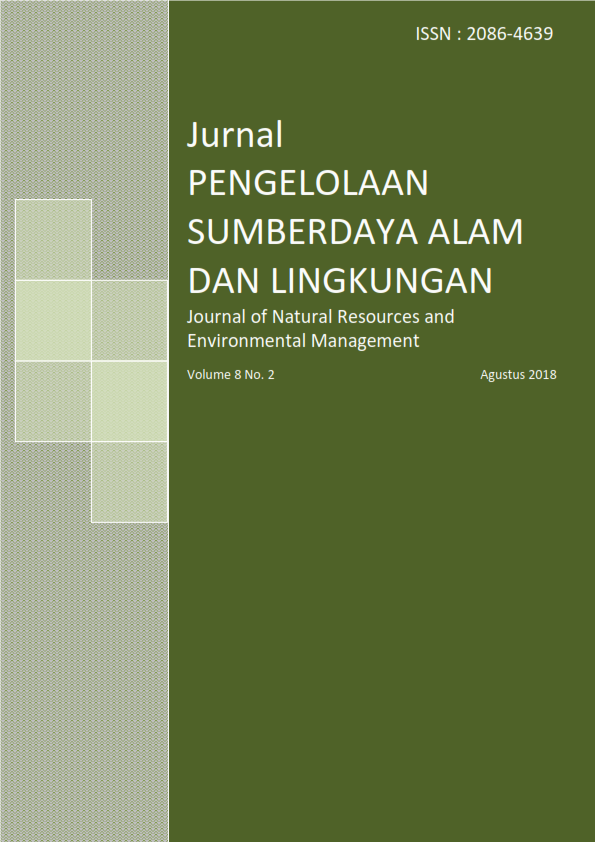JENIS PAKAN MEMPENGARUHI PRODUKSI BIOGAS DARI FESES GAJAH, STUDI KASUS GAJAH SUMATERA (Elephas maximus sumatranus Temminck, 1847) DI TAMAN MARGASATWA RAGUNAN, JAKARTA SELATAN
Abstract
Elephant dung is a source of methane gas, which the gas is the main contributor to greenhouse gas if not used as fuel. Wild elephants use grass leaves as their feed, but in Ragunan Wildlife Park, elephants are fed also with a combination of elephant grass, sweet potatoes, maize, and bananas, which aim to meet immediate nutritional needs and ensure their health. Therefore, this study examined the biogas production of elephant feces associated with the feed given. The purpose of this study is to investigate the contribution of biogas that is emitted from the elephant feces as a result of two kinds of feed, which were elephant grass and combination of elephant grass, sweet potatoes, maize, and bananas. Previously, the elephants were acclimatized for 4 days with the two types of feed. Fermentation of the feces was conducted by using simple fermenters by volume of 3.42 L for 28 days and performed measurements of temperature, pH, concentration of ammonia, concentration of volatile fatty acids, substrate degradation and production of biogas. The result showed that the composition of feed affects the physico-chemical characteristics of the feces, production of ammonia and volatile fatty acids, substrate degradation and production of biogas. The feces of Sumatran elephant fed with elephant grasses has higher potential for decomposition to mineralization into biogas and produce a higher proportion of methane gas carbon dioxide, than those fed with the combinated feed. This result needs to be a concern because with the fiber-rich feed like in their natural habitats, elephants have the potential to emit higher gas emissions. Therefore the biogas released from the elephant feces or other animals should be processed and utilized to meet the energy needs in the wildlife park itself.
References
Abbasi, T., S. M. Tauseef, S. A. Abbasi, 2012. Biogas Energy. Springer, Berlin.
Abubakar, B. S. U., N. Ismail, 2012. Anaerobic digestion of cow dung for biogas production. ARPN Journal of Engineering and Applied Science. 7(2), pp. 169-172.
Agus, F., Sulaeman, Suparto, Eviati, 2005. Petunjuk Teknis Analisis Kimia Tanah, Tanaman, Air dan Pupuk. Balai Penelitian Tanah, Badan Penelitian Pengembangan Teknologi (BPPT), Departemen Pertanian, Jakarta.
Association of Official Analytical Chemist, 1999. Official Methods of Analysis, 16th Edition. Association of Analytical Chemists, Washington DC.
Chen Y., J.J. Cheng, K.S. Creame, 2008. Inhibition of anaerobic digestion process: A review. Bioresource Technology. 99, pp. 4044–4064.
Ertem, F.C., 2011. Improving Biogas Production by Anaerobic Digestion of Different Substrates–Calculation of Potential Energy Outcomes. Thesis: Applied Environmental Science Halmstad University, Halmstad.
General Laboratory Procedure, 1996. Report of Diary Science. University of Wisconsin, Madison.
Gerardi, M., 2003. The Microbiology of Anaerobic Digesters. John Wiley & Sons. Inc., New Jersey.
Intergovernmental Panel on Climate Change, 2014. Mitigation of Climate Change, Chapter 11: Agriculture, Forestry and Other Land Use (AFOLU). https://www.ipcc.ch/pdf/assessment-report/ar5/wg3/ipcc_wg3_ar5_chapter11.pdf [20 Agustus 2017].
Kasisira, L.L., N.D. Muyiiya, 2009. Assessment of the effect of mixing pig and cow dung on biogas yield. Agricultural Engineering International: the CIGR Ejournal. Manuscript PM 1329, XI, pp. 1-7.
Masunga, G.S., Ø. Andresen, J.E. Taylor, S.S. Dhillion, 2006. Elephant dung decomposition and coprophilous fungi in two habitats of semi-arid Botswana. Mycological Research. 110(10), pp. 1214-1226.
Saggar S., R. Bhandral, C.B. Hedley, J.A. Luo, 2004. Review of emissions of methane, ammonia, and nitrous oxide from animal excreta deposition and farm effluent application in grazed pastures. New Zealand J. Agric. Res. 47, pp. 513–544.
Sanjaya, D., A. Haryanto, Tamrin, 2015. Produksi biogas dari campuran kotoran sapi dengan kotoran ayam. Jurnal Teknik Pertanian Lampung. 4(2), pp. 127-136.
Sannigrahi, A.K., 2015. Beneficial utilization of elephant dung through vermicomposting. International Journal of Recent Scientific Research. 6(6), pp. 4814-4817.
Saputra, T., S. Triatmojo, A. Pertiwiningrum, 2010. Produksi biogas dari campuran feses sapid an ampas tebu (baggase) dengan rasio C/N yang berbeda. Buletin Perternakan. 34(2), pp. 114-122.
Sukumar, R., 1989. The Asian Elephant: Ecology and Management. Cambridge Studies in Applied Ecology and Resource Management. Cambridge University Press, Cambridge, U.K.
Sukumar, R., 2003. The Living Elephants: Evolutionary Ecology, Behavior and Conservation. Oxford University Press, New York.
Triatmojo, S., 2004. Diktat Penanganan Limbah Peternakan. Jurusan Teknologi Hasil Ternak, Fakultas Peternakan Universitas Gajah Mada, Yogyakarta.
Understanding Global Warming Potentials. https://www.epa.gov/ghgemissions/understanding-global-warming-potentials [20 Agustus 2017].
Urley, D.E., S.D. Crissey dan H.F. Hintz, 1997. Elephants: Nutrition and Dietary Husbandry. Nutrition Advisory Group, Michigan.
Weiland, P., 2010. Biogas production: current state and perspectives. Applied Microbiology and Biotechnology. 85, pp. 849-860.
Wilkie, A., 2015. Biogas a Renewable Biofuel; Feedstocks for Biogas Production. http://biogas. ifas.ufl.edu/feedstocks.asp [25 Mei 2016].
Wiratmana, I.P.A., I.G.K. Sukadana, I.G.N.P. Tenaya, 2012. Studi eksperimental pengaruh variasi bahan kering terhadap produksi dan nilai kalor biogas kotoran sapi. Jurnal Energi dan Manufaktur. 5(1), pp. 22-32.
Authors
Authors who publish with this journal agree to the following terms:
- Authors retain copyright and grant the journal right of first publication with the work simultaneously licensed under a Creative Commons Attribution License that allows others to share the work with an acknowledgement of the work's authorship and initial publication in this journal.
- Authors are able to enter into separate, additional contractual arrangements for the non-exclusive distribution of the journal's published version of the work (e.g., post it to an institutional repository or publish it in a book), with an acknowledgement of its initial publication in this journal.
- Authors are permitted and encouraged to post their work online (e.g., in institutional repositories or on their website) prior to and during the submission process, as it can lead to productive exchanges, as well as earlier and greater citation of published work (See The Effect of Open Access).






